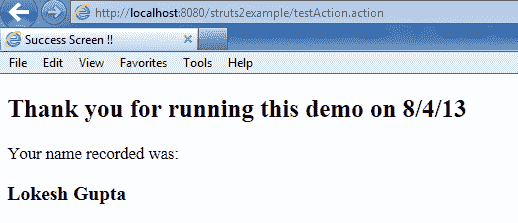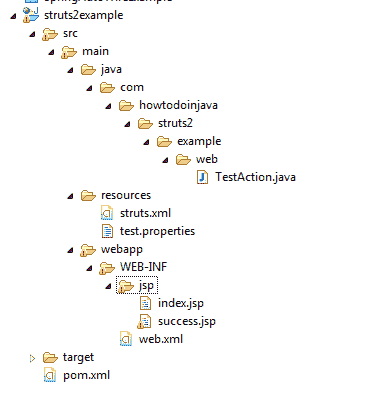原文: https://howtodoinjava.com/struts2/struts-2-hello-world-with-annotations/
在我以前的文章中,我写了许多关于 JAX-RS RESTEasy,Spring3,Hibernate 和其他 Java 框架,例如 Maven 或 junit 的示例和教程。 我还写了与 Struts2 helloworld 和 xml 配置 相关的帖子。 在本文中,我将更新先前的示例,以使用注解来配置 Struts2 应用。
有关信息,struts 注解是 struts 常规插件的一部分。
Sections in this post:Create maven web projectStruts2 dependenciesweb.xml changesWriting first action classComposing view filesTesting the application源码下载
创建 Maven Web 项目
我在这里不会吃太多空间。 您可以阅读有关如何创建 Maven Eclipse Web 项目的更多详细信息。 简而言之,使用以下命令。
mvn archetype:generate -DgroupId=com.howtodoinjava.struts2.example -DartifactIad=struts2example-DarchetypeArtifactId=maven-archetype-webapp -DinteractiveMode=falsecd struts2examplemvn eclipse:eclipse -Dwtpversion=2.0
Struts2 依赖项
我正在使用 maven 导入 Struts2 运行时依赖项。 这样做的好处是,您无需手动记住和寻找必需的依赖项,一举就能掌握所有内容。
<dependency><groupId>org.apache.struts</groupId><artifactId>struts2-core</artifactId><version>2.3.15.1</version></dependency><dependency><groupId>org.apache.struts</groupId><artifactId>struts2-convention-plugin</artifactId><version>2.3.15.1</version></dependency></dependencies>
web.xml的更改
需要以某种方式将 Struts 插入您的 Web 应用。 这意味着应将对应用的传入请求移交给 strut 进行处理。 这是通过在web.xml文件中添加过滤器定义来完成的。 此筛选器实质上将所有传入请求重定向到 StrutsPrepareAndExecuteFilter,然后使用配置来处理该请求。
另外,我传递了“actionPackages”初始化参数,以便可以扫描此包以查找必需的带注解的类。
<!DOCTYPE web-app PUBLIC"-//Sun Microsystems, Inc.//DTD Web Application 2.3//EN""http://java.sun.com/dtd/web-app_2_3.dtd" ><web-app><display-name>Archetype Created Web Application</display-name><filter><filter-name>struts2</filter-name><filter-class>org.apache.struts2.dispatcher.ng.filter.StrutsPrepareAndExecuteFilter</filter-class><init-param><param-name>actionPackages</param-name><param-value>com.howtodoinjava.struts2.example.web</param-value></init-param></filter><filter-mapping><filter-name>struts2</filter-name><url-pattern>/*</url-pattern></filter-mapping></web-app>
编写第一个类
这很重要,因为您将在此处编写实际的应用逻辑。 Struts2 操作通常扩展ActionSupport类,该类提供了一些方法来覆盖和更改应用流,并在两者之间注入业务逻辑。
@Namespace("/default")@ResultPath(value="/")@Results({@Result(name="success", location="WEB-INF/jsp/success.jsp"),@Result(name="input", location="WEB-INF/jsp/index.jsp")})public class TestAction extends ActionSupport{private static final long serialVersionUID = 1L;private String name;private Date nowDate;@Overridepublic void validate(){if (name==null || name.length()==0)addActionError(getText("error.enter.message"));}@Actions({@Action("/"),@Action("/test")})@Overridepublic String execute() throws Exception {nowDate = new Date();return ActionSupport.SUCCESS;}public String getName() {return name;}public void setName(String name) {this.name = name;}public Date getNowDate() {return nowDate;}}
注意:Struts2 动作看起来像 POJO 类,因为它们也必须充当动作形式,它们也是 Struts1 中的单独实体。
构建视图文件
这是一般步骤,涉及编写视图层,例如,在我们的例子中,我们正在编写 jsp 文件。 您可以使用消息资源从属性文件中获取消息,稍后在 i18n 中提供帮助。
index.jsp
<%@ page language="java" contentType="text/html; charset=ISO-8859-1" pageEncoding="ISO-8859-1"%><%@ taglib prefix="s" uri="/struts-tags" %><?xml version="1.0" encoding="UTF-8" ?><!DOCTYPE html PUBLIC "-//W3C//DTD XHTML 1.0 Transitional//EN" "http://www.w3.org/TR/xhtml1/DTD/xhtml1-transitional.dtd"><html><head><title>Struts2 hello world example</title><s:head/></head><body><h1><s:text name="welcome" /></h1><s:if test="hasActionErrors()"><div id="fieldErrors"><s:actionerror/></div></s:if><s:form action="test" namespace="/" method="post" name="myForm" theme="xhtml"><s:textfield name="name" size="40" maxlength="40" key="your.message-label"/><s:submit key="submit" /></s:form></body></html>
success.jsp
<%@ page language="java" contentType="text/html; charset=ISO-8859-1"pageEncoding="ISO-8859-1"%><%@ taglib prefix="s" uri="/struts-tags" %><?xml version="1.0" encoding="UTF-8" ?><!DOCTYPE html PUBLIC "-//W3C//DTD XHTML 1.0 Transitional//EN" "http://www.w3.org/TR/xhtml1/DTD/xhtml1-transitional.dtd"><html><head><title>Success Screen !!</title></head><body><h2>Thank you for running this demo on <s:property value="nowDate" /></h2><p>Your name recorded was: <h3><s:property value="name" /></h3></p></body></html>
我正在使用的消息资源文件是:
TestAction.properties
submit=Submityour.message-label=Your Namewelcome=Welcome to Struts2!error.enter.message=Please enter your name !!
测试应用
现在好运行我们的 helloworld 应用。 让我们点击浏览器。
键入http://localhost:8080/struts2example/,然后按Enter

按提交而不输入任何内容

输入您的姓名,然后按提交

项目的文件/文件夹树

就是这个带有注解的 Struts2 helloworld 应用的朋友。 如果要下载本教程的源代码,请按照以下给定的下载链接进行操作。
学习愉快!

